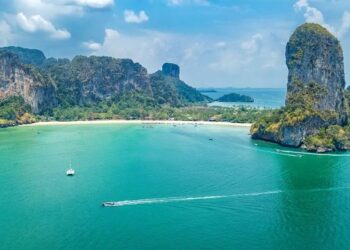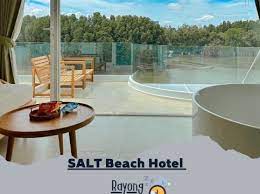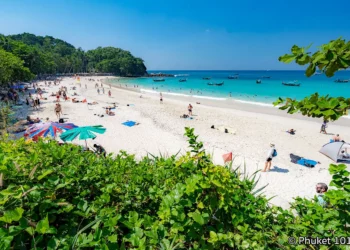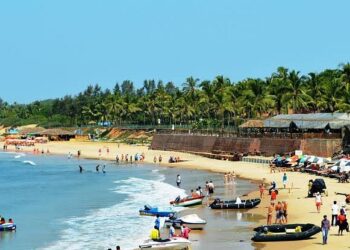Crowned on a hillock 3 km west of Kathmandu, Swayambhu, as locals usually call it, is one of the most revered Buddhist stupas in Nepal. The name Swayambhu, also one of the names of Lord Shiva, means “self-sprung.” It is said to have evolved spontaneously when the valley was created out of a primordial lake more than 2,000 years ago.
It is an ancient religious complex and the oldest stupa of its kind in Nepal. Although the stupa has Buddhist origin, it is revered by both Buddhists and Hindus.
If you’re keen on visiting this divine abode, here’s a detailed guide on how to reach it, what to see, and recommended accommodations nearby for your trip.
Fun Fact: It is also known as the “Monkey Temple” due to the many monkeys living in the hill areas.
Reaching Swayambhunath
By Air (For Domestic and International Travelers)
Swayambhunath is just 10 km away from Tribhuvan International Airport in Kathmandu.
A taxi ride from the airport will get you there in roughly 40 minutes.
By Road (From India & Other Nepali Cities)
If you’re coming from India, you can cross into Nepal through border points like Sunauli, Raxaul, or Kakarbhitta.
From those locations, buses are available to take you to Kathmandu.
Travelers from Nepali cities such as Pokhara, Chitwan, or Lumbini can also find regular buses or taxis heading to Kathmandu.
Entry Fees and Visiting Hours
Operating Hours: Open daily from 6 a.m. to 7 p.m.
Admission Costs:
Free for Nepali citizens
NPR 50 for SAARC country nationals
NPR 200 for other foreign visitors
Architecture of Swayambhunath
The stupa consists of a dome at the base, above which is a cubical structure painted with the eyes of Buddha looking in all four directions. Pentagonal torans are present above each of the four sides, with statues engraved on them. Behind and above the torans, there are thirteen tiers. Above all the tiers, there is a small space, atop which sits the Gajur. The stupa has many artifacts inside it.
History and Mythology
Historical records found on a stone inscription provide evidence that the stupa was already an important Buddhist pilgrimage destination by the 5th century AD. Its origins, however, date to a much earlier time, long before the arrival of Buddhism in the valley.
Various legends regarding the stupa in the 15th-century Swayambhu Purana, tells of a divine lotus, planted by a Buddha, which blossomed from the lake that once covered Kathmandu Valley thousands of years ago. The lotus radiated a brilliant rainbow lights, and the name of the place came to be Swayambhu, meaning “Self-Created”. Various Saints, monks and sages, traveled to the lake to venerate this miraculous light for its power in granting enlightenment.
During this time, the Bodhisattva Manjushri was meditating at the sacred mountain of Wu Tai Shan and had a vision of the dazzling Swayambhu light. Manjushri flew across the mountains of China and Tibet on his blue lion to worship the lotus. Deeply impressed by the power of the radiant light, Manjushri felt that if the water were drained from the lake, Swayambhu would become more easily accessible to human pilgrims. With a great sword, Manjushri cut a gorge in the mountains surrounding the lake. The water drained away, leaving the valley of present-day Kathmandu. The lotus was then transformed into a hill, and the light became the Swayambhunath Stupa.
Accomodations near Swayambhunath
Swayambhu View Guest House (0.4 km away and 8 minutes’ walk)
Affordable, comfortable, and equipped with a shared kitchen, free Wi-Fi, private bathrooms, and views of the valley and stupa from the rooftop. Prices range from 1,500 to 2,500 NPR per night.
Sherpa Home Hotel (10-minute walk, 0.5 km)
Breakfast, free Wi-Fi, a snack bar, bike rentals, and tidy rooms with garden views are all included. Prices range from NPR 2,000 to 3,500 per night.
Hotel Vajra (15-minute walk, 0.8 km)
Mid-range, traditional Nepali charm featuring a restaurant, rooftop views, a lush garden, and artistic rooms with contemporary conveniences. Prices range from NPR 4,000 to 6,000 per night.
Karma Suites (walking 5 minutes, 0.3 km)
This bed-and-breakfast near the stupa features a garden, terrace, and free breakfast. Prices range from NPR 2,500 to 4,000 per night.
Dining Options Close to Swayambhunath
The New Orleans Cafe (0.6 km, 12-min walk)
A cozy spot with a variety of Western and Nepali dishes, including vegetarian-friendly options. It’s a great place for breakfast or a casual lunch with outdoor seating and views of the stupa.
Stupa View Restaurant (0.3 km, 6-min walk)
Perfect for a meal with a view, this restaurant offers a selection of traditional Nepali dishes along with some international fare. The ambiance is relaxed and offers great views of the stupa.
Buddha Café (0.5 km, 10-min walk)
Located near the Swayambhunath area, it’s a charming spot offering a mix of Nepali and Tibetan food. You can enjoy momos, dal bhat, and Tibetan butter tea with a peaceful atmosphere.
Bakers Café (1 km, 15-min walk)
A more upscale option serving sandwiches, salads, and bakery items. The café is well known for its fresh-baked goods, pastries, and a variety of coffee options.
Final Thoughts
Swayambhunath stupa isn’t just yet another stupa, rather it’s a peaceful retreat that provides a window into Nepal’s spiritual life. Whether you’re craving stunning views, cultural richness, or simply a place to relax, it’s a must-see spot in Kathmandu. Feel the Buddhist vibe—and be a little cautious of the monkeys!









